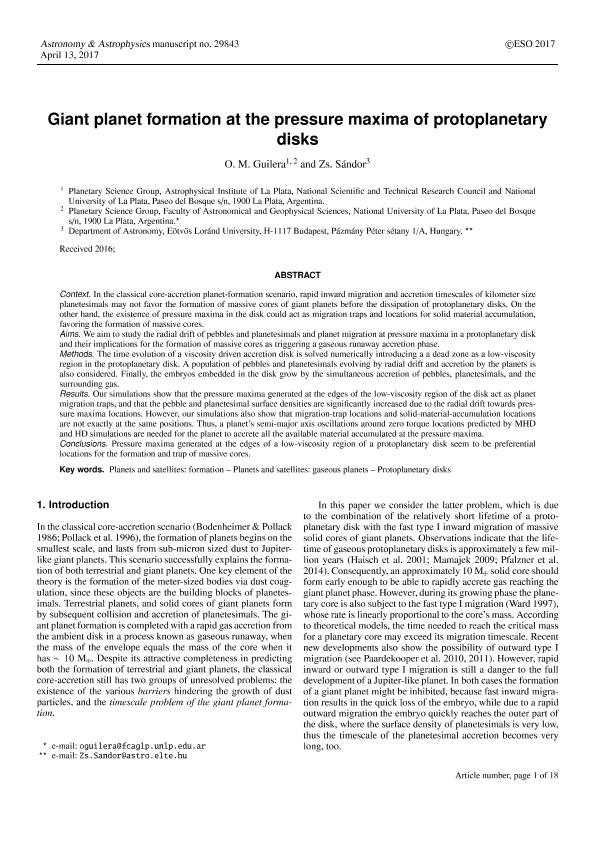Mostrar el registro sencillo del ítem
dc.contributor.author
Guilera, Octavio Miguel

dc.contributor.author
Sandor, Zs.
dc.date.available
2018-04-06T13:42:48Z
dc.date.issued
2017-04
dc.identifier.citation
Guilera, Octavio Miguel; Sandor, Zs.; Giant planet formation at the pressure maxima of protoplanetary disks; EDP Sciences; Astronomy and Astrophysics; 604; 4-2017; A10
dc.identifier.issn
0004-6361
dc.identifier.uri
http://hdl.handle.net/11336/41049
dc.description.abstract
Context. In the classical core-accretion planet-formation scenario, rapid inward migration and accretion timescales of kilometer sizeplanetesimals may not favor the formation of massive cores of giant planets before the dissipation of protoplanetary disks. On theother hand, the existence of pressure maxima in the disk could act as migration traps and locations for solid material accumulation,favoring the formation of massive cores.Aims. We aim to study the radial drift of pebbles and planetesimals and planet migration at pressure maxima in a protoplanetary diskand their implications for the formation of massive cores as triggering a gaseous runaway accretion phase.Methods. The time evolution of a viscosity driven accretion disk is solved numerically introducing a a dead zone as a low-viscosityregion in the protoplanetary disk. A population of pebbles and planetesimals evolving by radial drift and accretion by the planets isalso considered. Finally, the embryos embedded in the disk grow by the simultaneous accretion of pebbles, planetesimals, and thesurrounding gas.Results. Our simulations show that the pressure maxima generated at the edges of the low-viscosity region of the disk act as planetmigration traps, and that the pebble and planetesimal surface densities are significantly increased due to the radial drift towards pressuremaxima locations. However, our simulations also show that migration-trap locations and solid-material-accumulation locationsare not exactly at the same positions. Thus, a planet?s semi-major axis oscillations around zero torque locations predicted by MHDand HD simulations are needed for the planet to accrete all the available material accumulated at the pressure maxima.Conclusions. Pressure maxima generated at the edges of a low-viscosity region of a protoplanetary disk seem to be preferentiallocations for the formation and trap of massive cores.
dc.format
application/pdf
dc.language.iso
eng
dc.publisher
EDP Sciences

dc.rights
info:eu-repo/semantics/openAccess
dc.rights.uri
https://creativecommons.org/licenses/by-nc-sa/2.5/ar/
dc.subject
Planets
dc.subject
Gaseous Planets
dc.subject
Protoplanetary Disks
dc.subject
Satellites
dc.subject
Formation of Planets
dc.subject
Formation of Satellites
dc.subject.classification
Astronomía

dc.subject.classification
Ciencias Físicas

dc.subject.classification
CIENCIAS NATURALES Y EXACTAS

dc.title
Giant planet formation at the pressure maxima of protoplanetary disks
dc.type
info:eu-repo/semantics/article
dc.type
info:ar-repo/semantics/artículo
dc.type
info:eu-repo/semantics/publishedVersion
dc.date.updated
2018-03-26T14:39:03Z
dc.journal.volume
604
dc.journal.pagination
A10
dc.journal.pais
Francia

dc.description.fil
Fil: Guilera, Octavio Miguel. Universidad Nacional de La Plata. Facultad de Ciencias Astronómicas y Geofísicas; Argentina. Consejo Nacional de Investigaciones Científicas y Técnicas. Centro Científico Tecnológico Conicet - La Plata. Instituto de Astrofísica La Plata. Universidad Nacional de La Plata. Facultad de Ciencias Astronómicas y Geofísicas. Instituto de Astrofísica La Plata; Argentina
dc.description.fil
Fil: Sandor, Zs.. Department Of Astronomy, Eötvös Loránd University; Hungría
dc.journal.title
Astronomy and Astrophysics

dc.relation.alternativeid
info:eu-repo/semantics/altIdentifier/url/http://www.aanda.org/10.1051/0004-6361/201629843
dc.relation.alternativeid
info:eu-repo/semantics/altIdentifier/doi/http://dx.doi.org/10.1051/0004-6361/201629843
Archivos asociados
